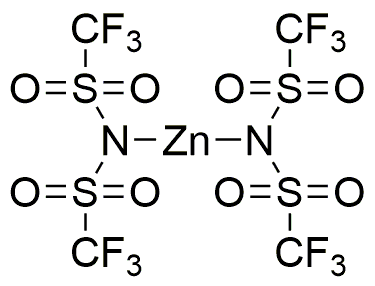Zinc(II) bis(trifluoromethanesulfonyl)imide is widely utilized in research focused on:
- Energy Storage: This compound is used in the development of advanced electrolytes for lithium-ion batteries, enhancing their efficiency and lifespan.
- Catalysis: It serves as a catalyst in various organic reactions, improving reaction rates and selectivity, which is crucial for the pharmaceutical industry.
- Electrochemical Applications: The compound is effective in electrochemical sensors, providing high sensitivity and specificity for detecting various analytes.
- Material Science: It is applied in creating high-performance polymers and coatings, offering superior thermal and chemical stability compared to traditional materials.
- Environmental Remediation: This chemical is explored for its potential in removing heavy metals from wastewater, making it valuable for industries focused on sustainability.
General Information
Properties
Safety and Regulations
Applications
Zinc(II) bis(trifluoromethanesulfonyl)imide is widely utilized in research focused on:
- Energy Storage: This compound is used in the development of advanced electrolytes for lithium-ion batteries, enhancing their efficiency and lifespan.
- Catalysis: It serves as a catalyst in various organic reactions, improving reaction rates and selectivity, which is crucial for the pharmaceutical industry.
- Electrochemical Applications: The compound is effective in electrochemical sensors, providing high sensitivity and specificity for detecting various analytes.
- Material Science: It is applied in creating high-performance polymers and coatings, offering superior thermal and chemical stability compared to traditional materials.
- Environmental Remediation: This chemical is explored for its potential in removing heavy metals from wastewater, making it valuable for industries focused on sustainability.
Documents
Safety Data Sheets (SDS)
The SDS provides comprehensive safety information on handling, storage, and disposal of the product.
Product Specification (PS)
The PS provides a comprehensive breakdown of the product’s properties, including chemical composition, physical state, purity, and storage requirements. It also details acceptable quality ranges and the product's intended applications.
Certificates of Analysis (COA)
Search for Certificates of Analysis (COA) by entering the products Lot Number. Lot and Batch Numbers can be found on a product’s label following the words ‘Lot’ or ‘Batch’.
*Catalog Number
*Lot Number
Certificates Of Origin (COO)
This COO confirms the country where the product was manufactured, and also details the materials and components used in it and whether it is derived from natural, synthetic, or other specific sources. This certificate may be required for customs, trade, and regulatory compliance.
*Catalog Number
*Lot Number
Safety Data Sheets (SDS)
The SDS provides comprehensive safety information on handling, storage, and disposal of the product.
DownloadProduct Specification (PS)
The PS provides a comprehensive breakdown of the product’s properties, including chemical composition, physical state, purity, and storage requirements. It also details acceptable quality ranges and the product's intended applications.
DownloadCertificates of Analysis (COA)
Search for Certificates of Analysis (COA) by entering the products Lot Number. Lot and Batch Numbers can be found on a product’s label following the words ‘Lot’ or ‘Batch’.
*Catalog Number
*Lot Number
Certificates Of Origin (COO)
This COO confirms the country where the product was manufactured, and also details the materials and components used in it and whether it is derived from natural, synthetic, or other specific sources. This certificate may be required for customs, trade, and regulatory compliance.


